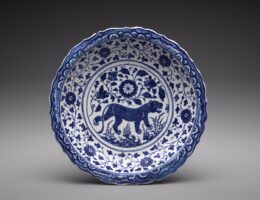IRAN ART EXHIBITION: PERSIAN POTTERY CRAFTS HAVE THE TOP RANK IN THE WORLD
Archaeological researches show that Lalejin located in the ancient city of Hamadan or Ecbatana has 7500 years’ history record dating back to ancient Persia, as revealed by excavations in the past and recent years at Ecbatana Hill, Gyan in Nahavand and Nushijan in Malayer in Hamedan Province.
Pottery has been handed down from generation to generation in Lalejin. This is their ancient and traditional art. The products have got good quality and the materials used are good enough to some extent, Iran Press reported.
Lalejin is also the centre of pottery production in the Middle East.
The small town of Lalejin celebrated its designation as the World Pottery Capital by the World Crafts Council in 2016.
According to official statistics, around 80 percent of Lalejin’s population are potters, ceramists and involved in either pottery or related industries. 101/211/205

The village of Mend is the only pottery center in the east of Iran, located three kilometers north of Gonabad, the northeastern province of Khorasan Razavi, with a population of approximately 1000 people. This village’s residents are also engaged in brick, pottery, and tile making besides farming.
The pottery industry in Mend can be traced back to the 3rd millennium BC. without a specific name until the early 12th century; however, a new type of pottery has appeared since then which is known as Faience Pottery.
The patterns and composition of Mend potteries closely resemble those of Meybod products. They are also closely similar to the patterns of Shahreza potteries so that they are hard to distinguish.
IRAN ART EXHIBITION: A variety of traditional potteries are produced in this region using either red clay or Faience ceramic. Both methods differ in terms of their materials and the process of making the body. Faience is a type of ceramic made from white clay. These types of ceramics are mainly made from silica or flint, bentonite, and kaolin.
The surrounding mines produce bentonite and kaolin. Upon extraction, flint is pounded with a hammer to be broken into smaller pieces. Red clay pottery is another type of pottery made from clay, and is newer than faience works in the area.
Traditionally, hand-made potteries produced wares such as birds, animals and bulks formed through the molding of vases, thermoses, and other objects, embellished with relief motifs. Since Mend’s products are wheel-made, they are produced more easily and are a popular choice among people due to their versatility.
There is also a high demand for underglaze painting here. Many of the motifs on Mend pottery come from symbols and rituals rooted in people’s beliefs. On ceramics, human beings, animals, plants, and geometrical patterns are the most commonly used motifs. An exemplar of Mend’s wares typically depicts the human face surrounded by lines. Potteries like these are often regarded as the most important of Mend. There are many motifs depicting animals, such as chickens, fish, butterflies, etc., which are painted in red and yellow.
With 14 entries, Iran ranks first globally for the number of cities and villages registered by the World Crafts Council, as China with seven entries, Chile with four, and India with three ones come next.






